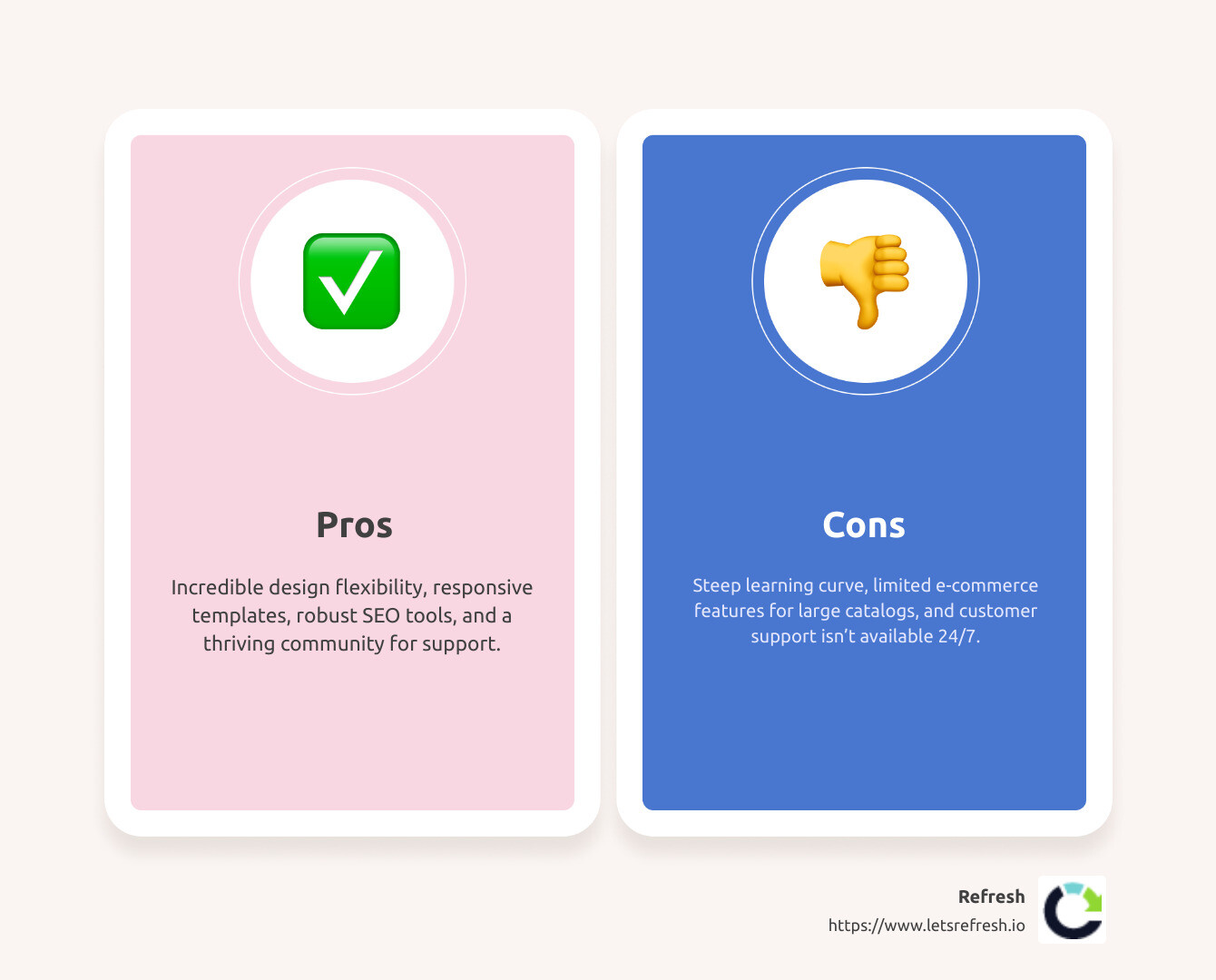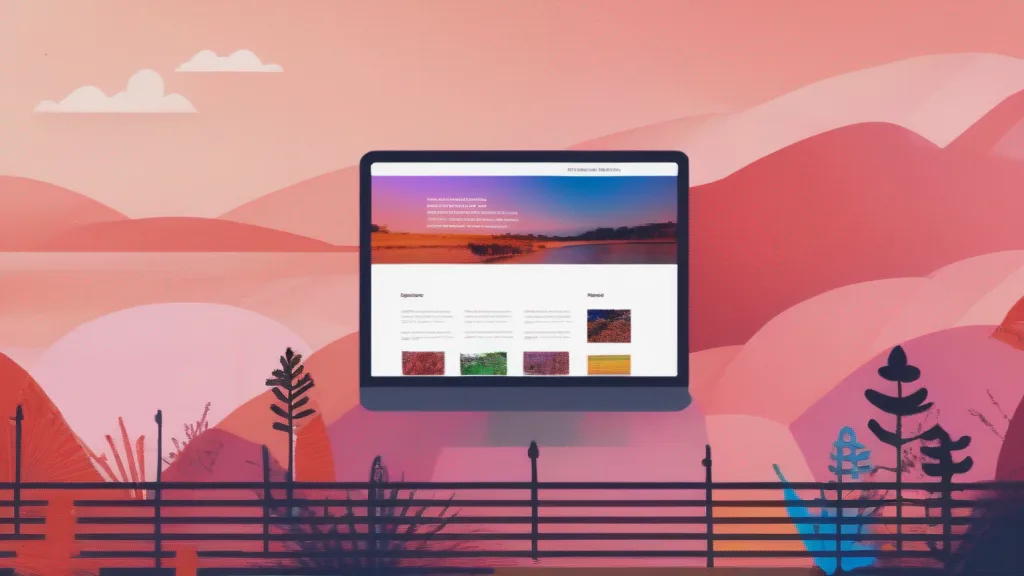
Alex Palmiere
January 16, 2026
If you're searching for Webflow platform reviews, you'll want find out how it stacks up in the crowded landscape of website builders. Here’s a quick summary:
We'll dive deep into what makes Webflow stand out and where it might fall short. Our goal is to help tech startup founders and web designers decide if Webflow is the right fit for their needs.

By the end of this review, you'll have a clear understanding of Webflow's offerings, user experiences, and how it compares to other popular website builders. Whether you're looking to improve your online visibility, attract more customers, or streamline your digital strategy, we're here to guide you.
Webflow is a website building platform that empowers users to create stunning websites without writing a single line of code. It's a cloud-based, 'software as a service' (SaaS) tool that runs directly in your web browser. This means you don't need to download or install anything to get started.
Webflow is often touted as a no-code web development tool. This means you can design and build websites without needing any programming skills. However, for those who are comfortable with coding, Webflow does allow custom HTML, CSS, and JavaScript edits. This makes it versatile for both beginners and advanced users.
One of Webflow's standout features is its emphasis on design flexibility. You get a large selection of customizable templates that you can tweak to fit your brand perfectly. The platform's visual designer tool lets you see changes in real-time, making it easier to perfect your site's look and feel.
When it comes to hosting, Webflow offers two main options:
Most users opt for the first method due to the convenience and reliability of Webflow's hosting services. According to Internet statistics company Builtwith.com, there are around 432,904 live websites built and hosted with Webflow. This includes notable clients like Zendesk, Dell, and Upwork.
As a SaaS platform, Webflow operates on a subscription basis. You pay a monthly or yearly fee to access its features. This model ensures that you always have the latest updates and features without needing to manage any software installations or updates yourself.
Webflow is aimed at a wide range of users, including:
The platform’s versatility makes it suitable for various types of websites, from simple blogs to complex e-commerce stores.
Founded in 2013 and based in San Francisco, Webflow has grown rapidly. With over $140 million in funding and a valuation of $4 billion, it’s clear that Webflow is here to stay. It positions itself as a powerful tool for creating professional websites without the complexity of traditional web development.

Webflow offers an impressive blend of design flexibility, no-code capabilities, and reliable hosting options. It's a robust tool for anyone looking to create a professional, visually appealing website without diving into code.
Next, we'll dive into the various pricing plans Webflow offers to help you decide if it fits your budget.
Webflow's pricing can be a bit tricky to steer, but understanding it is key to making the right choice for your needs. It offers three main types of plans: Site plans, Ecommerce plans, and Workspace plans. Each caters to different user needs and project scales.
Site plans are ideal for personal websites, blogs, or business sites. Here’s a quick breakdown:
The main differences revolve around access to a content management system (CMS), the number of CMS items you can create, monthly visitor limits, storage space, and the number of site editors.
Ecommerce plans are custom for online stores. They include:
Key differences here include the number of products you can sell, transaction fees, and the number of staff accounts you can have.
Workspace plans are more suitable for professional web designers and agencies. These plans focus on collaboration and code export:
These plans differ based on the number of users, number of sites, publishing permissions, and whether you can add custom code or export site code.
The pricing structure can be complex, but simply put, the more you pay, the more features and flexibility you get. The Site plans and Ecommerce plans include hosting, CMS, and custom domain mapping. However, Workspace plans require an additional Site or Ecommerce plan for hosting and CMS features.
Key Features across plans include:
Webflow’s pricing may seem complicated, but it offers a range of features to suit different needs and budgets. Next, let's explore the key features of Webflow to see what else it brings to the table.
Webflow offers a vast library of over 2,000 templates, including 48 free ones, catering to various industries like portfolios, blogs, and ecommerce. These templates are modern, aesthetically pleasing, and fully customizable. You can search for templates based on industry, language, style, and design features, making it easy to find the perfect fit for your project. However, once you choose a template, you can't switch to another one, so choose wisely.
The Visual Designer is Webflow’s standout feature. It allows you to build and edit your website in real-time without writing a single line of code. This visual builder is intuitive but has a learning curve. Webflow University offers extensive resources, including the Webflow 101 Crash Course, to help you get started. The designer interface supports drag-and-drop editing and advanced customizations, making it a powerful tool for creating unique websites.
Webflow’s CMS is designed to make content management straightforward and efficient. It allows you to create and manage blog posts, product listings, and other types of content easily. However, the CMS has some limitations, such as a 150-page limit for static pages and automatic date changes when editing published articles. Despite these drawbacks, the CMS is robust enough for most small to medium-sized projects.
Webflow excels in creating advanced animations and interactions through its Webflow Interactions feature. This allows you to add unique scroll effects, hover effects, and page transitions without needing to understand JavaScript. There are around 20 preset animation types like 'fade', 'shrink', and 'spin' to get you started. You can set various triggers, such as page load, mouse click, or scroll into view, to make your site interactive and engaging.
All Webflow templates are fully responsive, meaning they automatically adjust to fit any device, be it a desktop, tablet, or mobile phone. Webflow also provides a separate canvas for mobile design, allowing you to customize how your site looks on smaller screens. You can even preview your site on specific smartphone models like Apple, Samsung, and Google phones, ensuring a consistent user experience across devices.
Webflow’s key features make it a versatile and powerful tool for building custom websites. Whether you're a beginner or a seasoned designer, Webflow offers the flexibility and control you need to bring your vision to life. Next, let's hear what users have to say about their experiences with Webflow.
Design Control
Webflow gives you complete control over your website's design. Unlike many other platforms, you can customize every aspect of your site. Whether you want to tweak the smallest details or overhaul the entire layout, Webflow lets you do it. This makes it ideal for designers who want their site to look exactly how they envision it.
No-Code
One of Webflow’s standout features is its no-code approach. You don’t need to know how to code to create a stunning website. The platform uses a visual interface that lets you drag and drop elements to build your site. This makes it accessible for beginners while still offering advanced options for seasoned developers.
Visual Builder
Webflow’s visual builder is a game-changer. You can see your changes in real-time, which speeds up the design process. This "what-you-see-is-what-you-get" (WYSIWYG) approach eliminates guesswork and allows for immediate feedback on your design choices.
SEO-Friendly
Webflow is SEO-friendly right out of the box. You can easily edit page titles, URLs, and meta descriptions. Adding alt tags to images and creating 301 redirects is straightforward. Webflow even allows you to edit your schema markup and robots.txt file. All these built-in features help your site rank higher in search engine results.
Fast Loading Speeds
Page speed is crucial for user experience and SEO. Webflow sites generally load quickly, often scoring 90+ on Google’s PageSpeed Insights tool. The platform also offers options to minimize CSS and scripts, further improving load times. For image-heavy pages, Webflow’s ‘image load’ settings help ensure fast loading speeds by displaying images based on screen resolution.
Security
Webflow takes security seriously. Every site comes with a free SSL certificate and DDoS protection. The platform also provides unlimited site backups, so your work is always safe. Constant threat monitoring adds an extra layer of security, giving you peace of mind.
These pros make Webflow a powerful tool for anyone looking to build a custom website. Whether you’re a novice or an experienced designer, Webflow offers the flexibility and control you need. Now, let's dive into some of the cons of using Webflow.
A challenge with Webflow is its steep learning curve. While the platform is marketed as a no-code tool, some understanding of HTML and CSS is necessary to get the most out of it. Many users find it more suited to developers rather than beginners. As one user mentioned, "Despite claims otherwise, it’s more suited to a target market of developers rather than web design novices."
Webflow's pricing structure can be confusing. There are multiple plans, including Site Plans, Ecommerce Plans, and Workspace Plans, each with different features and traffic limits. Users often find it hard to choose the right plan without extensive research. One user pointed out, "The pricing structure is very confusing," which can be a deterrent for those looking for straightforward pricing.
Once you’ve chosen a template in Webflow, you’re stuck with it. Switching templates is not an option, which means you have to be very careful when making your initial choice. This limitation can be frustrating, especially if you realize later that a different template would have been a better fit.
Webflow also has limitations in image editing. The platform lacks the comprehensive image editing tools found in some other website builders. This means you often need to use external tools to edit images before uploading them to Webflow.
These cons highlight some of the areas where Webflow could improve. While it offers powerful features, these limitations can make it less appealing for certain users. Next, we'll explore user feedback on Webflow to see how these pros and cons play out in real-world scenarios.
User feedback on Webflow is generally positive, especially when it comes to the platform's design flexibility and interactive features. However, there are some mixed opinions worth noting.
Many users highlight Webflow's visual designer as a standout feature. It allows for a high level of customization without needing to write code. One user shared, "Webflow let me create a website that looked exactly how I envisioned it, without having to touch a single line of code."
However, some users do mention the steep learning curve. Beginners may find the extensive set of features overwhelming at first. But, as another user pointed out, "Once you get the hang of it, the possibilities are endless."
The Webflow community is very active and supportive. The Webflow forum is frequently cited as a valuable resource. Technically-skilled users often provide quick and effective solutions to issues. One community member noted, "The forum is my go-to place for troubleshooting. The responses are fast and usually spot-on."
Webflow University is another major asset. It offers a plethora of tutorials, video guides, and articles to help users get the most out of the platform. Users generally praise the quality and comprehensiveness of these resources. "Webflow University is like having a personal tutor. The tutorials are easy to follow and incredibly detailed," said one satisfied user.
Webflow's customer support is limited to email and operates Monday through Friday, 6am-6pm Pacific Time. While the response time is typically within 24-48 hours, some users find this inadequate compared to platforms that offer 24/7 support. "Email support is decent, but I wish they had live chat or phone support for quicker resolutions," one user commented.
However, the quality of the support received is generally good. "Whenever I've had to reach out to Webflow support, they've been helpful and resolved my issues within a day," another user shared.
In summary, user feedback indicates that Webflow excels in design flexibility and community support, but could improve in areas like learning curve and customer service options. Next, we'll compare Webflow to its competitors to see how it stacks up.
When comparing Webflow to its competitors, several key factors come into play: unique features, user-friendliness, site speed, security, and SEO. Let's dive into each of these aspects to see how Webflow measures up.
Webflow stands out for its visual editor and design capabilities. Unlike other platforms, Webflow allows for intricate animations, parallax scrolling, and microinteractions without needing to write any code. This makes it a favorite among designers looking for creative freedom.
One user said, "The ability to customize every tiny detail sets Webflow apart from other builders. It's like having Photoshop for websites."
While Webflow offers powerful tools, it has a steeper learning curve compared to other website builders. Beginners might find it challenging initially, but resources like Webflow University help ease the learning process.
"Webflow's interface can be overwhelming at first, but the tutorials are a lifesaver," commented a new user.
Webflow sites generally load quickly, which is a big plus for SEO and user experience. Google’s PageSpeed Insights often show high scores for Webflow templates.
However, heavy animations and large images can slow down performance. To maintain fast loading speeds, Webflow offers options like lazy loading for images and CSS minification.
Security is another strong point for Webflow. It offers automatic backups and a free SSL certificate, ensuring data protection and trustworthiness.
"Webflow’s built-in security features give me peace of mind," noted one user.
Webflow excels in SEO capabilities, offering features like customizable 301 redirects, automatically generated sitemaps, and advanced control over metadata.
"Webflow makes it easy to optimize my site for search engines," a digital marketer shared.
However, users need to be cautious with animations and image sizes to meet Google’s Core Web Vitals targets.
In conclusion, Webflow offers a unique blend of design flexibility and robust features but requires some effort to master. Next, we'll tackle some frequently asked questions about Webflow.
Yes, Webflow is highly regarded for its robust design capabilities and flexibility. It allows users to create unique, responsive websites without needing to write code. According to Forbes, Webflow is particularly strong in creative visuals and interactive design features.
However, it's not the easiest platform to use, especially for beginners. While it offers a guided onboarding tour and a comprehensive help center, it is more suited for those who have experience with other design tools.
Webflow may not be suitable for everyone. Here are a few reasons why some users might avoid it:
Both platforms have their strengths and weaknesses. Here’s a quick comparison:
In summary, while WordPress is more widely used, Webflow offers a more streamlined and visually driven experience. It’s a better choice for those looking for design flexibility and fewer technical problems.
Next, we'll dig into a detailed comparison between Webflow and its competitors.
In conclusion, Webflow stands out as a highly versatile and powerful website builder, especially for those who prioritize design flexibility and a no-code approach. Its visual designer, responsive templates, and built-in SEO tools make it a favorite among creative professionals and small businesses alike.
Summary:
Webflow excels in several key areas:
However, it's not without its drawbacks:
Final Thoughts:
Webflow is a unique platform with a clear focus on design and user experience. It’s particularly well-suited for designers, freelancers, and small businesses looking to create standout websites without delving into code. While it may not be the cheapest or easiest option, its strengths in design and performance make it a compelling choice.
Refresh Agency Recommendation:
At Refresh, we believe in leveraging the best tools to deliver exceptional results for our clients. Webflow’s features align perfectly with our commitment to quality and innovation. If you’re considering building a new website or revamping an existing one, we highly recommend giving Webflow a try.
Why Choose Refresh?
Partnering with an expert Webflow agency like Refresh can help you steer the platform’s complexities and maximize its potential. Our team is well-versed in creating visually stunning, high-performing websites that align with your brand and business goals.
Ready to take your website to the next level? Schedule a call with us to discuss how we can help you harness the full power of Webflow.
For more detailed comparisons and insights, check out our other articles on Webflow Tips and Webflow platform reviews.

.avif)